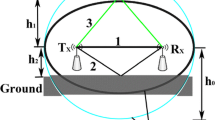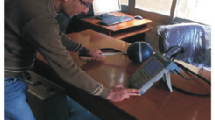Abstract
This paper presents the results of investigation of fixed wireless access performance based on IEEE802.16 standard in wide campus environment. Measurements have been conducted at 5.8 GHz that includes various parameters in different outdoor environments to study the effect of vegetation, street and building. The primary goal of this work is to investigate the performance of received signal strength during daytime and night. Based on the measurement result, small signal deviation recorded for daytime and night. The channel capacity is found varied with environment conditions, wind speed, humidity and temperature. The extent of changes based on blockage is examined as well. The excess loss due to vegetation is ranging from 5.14 to 31.17 dB. Within the research framework, the empirical values obtained are to be scintillated with the statistical models. Henceforth, it is vital to discover the interrelation within the outstanding statistical distributions, such as log-normal, Gaussian, Rayleigh, Rician and Nakagami distributions. In such models, it is found that log-normal distribution best fit the path and excess loss models.











Similar content being viewed by others
References
Weissberger, M. A. (1982). An initial critical summary of models for predicting the attenuation of radio waves by trees. ECAC-TR-81-101, Electromagnetic Compact. Analysis Center, Annapolis, MD.
I. T. U. (ITU-R. ITU-R P.833-7) (2007). Attenuation in vegetation.
Dalley, J. E., Smith, M. S., & Adams, D. N. (1999). Propagation losses due to foliage at various frequencies. In IEEE national conference on antenna and propagation (pp. 267–270).
Bannister, K., Giorgetti, G., & Gupta, S. K. S. (2008). Wireless sensor networking for ‘hot’ applications: Effects of temperature on signal strength, data collection and localization. In 5th workshop on embedded networked sensors.
Lin, S., Zhang, J., Zhou, G., Gu, L., He, T., & Stankovic, J. A. (2006). ATPC: Adaptive transmission power control for wireless sensor networks. In 4th international conference on embedded networked sensor systems.
Hashim, M. H., & Stavrou, S. (2005). Wind influence on radio waves propagating through at 1.8 GHz. IEEE Antennas and Wireless Propagation Letters, 4, 143–146.
Atapattu, S., Chinthatellambura, & Jiang, H. (2010). Representation of composite fading and shadowing distributions by using mixtures of gamma distributions. In IEEE wireless communications and networking conference (pp. 1–5).
Rahman, N. Z. A., Geok, T. K., Omer, A., Rahman, T. A., & Reza, A. W. (2013). Radio propagation studies at 5.8 GHz for point-to-multipoint applications incorporating vegetation effects. Wireless Personal Communications, 72(1),709–728.
Chen, H.-H., & Guizani, M. (2006). Next generation wireless systems and networks (pp. 23–26). Chichester: Wiley.
Liang, J., Liang, Q., & Samn, S. W. (2010). A propagation environment modeling in foliage. EURASIP Journal on Wireless Communications and Networking, 2010, 1–12.
Perras, S., & Bouhard, L. (2002). Fading characteristics of RF signals due to foliage in frequency bands from 2 to 60 GHz. Wireless Personal Multimedia Communications, 1, 261–267.
Bertoni, H. L. (2000). Radio propagation for modern wireless systems. Englewood Cliffs: Prentice Hall.
Rappaport, T. S. (2001). Wireless communications: Principles and practice (2nd ed.). New Jersey: Prentice Hall PTR.
Ly, P. L., Rahman, T. A., & Abu, M. K. (2010). Investigation of foliage effects via remote data logging at 5.8 GHz. WSEAS Transactions on Communications, 9(4), 237–247.
Voldhaug, J. E., Braten, L. E., & Sander, J. (2010). Deployable WiMAX in a forest area; Channel measurements and modelling. In IEEE MILCOM 2010. San Jose.
Dapper, M., Wells, J. S., Schwallie, T., & Huon, L. (2003). RF propagation in short range sensor communication. In Proceedings of the SPIE conference on unattended ground sensor technologies and applications (pp. 330–340).
Huang, X., Chen, B., Cui, H.-L., Stamnes, Jakob J., Pastore, R., Farwell, M., et al. (2006). Radio-propagation model based on the combined method ray tracing and diffraction. IEEE Transactions on Antennas and Propagation, 54(4), 1284–1291.
Al-Nuaimi, M. O., & Hammoudeh, A. M. (1994). Measurements and predictions of attenuation and scatter of microwave signals by trees. IEE Proceedings-Microwaves, Antennas and Propagation, 141(2), 70–76.
Savage, N., & Ndzi, D. (2003). Radio wave propagation through vegetation: Factors influencing signal attenuation. Radio Science, 38(5), 1–13.
Meireles, R., Boban, M., Tonguz, P. O., & Barros, J. (2010). Experimental study on the impact of vehicular obstructions in VANETs. In IEEE vehicular networking conference (pp. 338–345).
Boban, M., Vinhoza, T. T. V., Ferreira, M., Barros, J., & Tonguz, P. O. (2011). Impact of vehicles as obstacles in vehicular ad hoc networks. IEEE Journal on Selected Areas in Communications, 59(1), 15–18.
Hashim, M. H., & Stavrou, S. (2006). Measurements and modelling of wind influence on radiowave propagation through vegetation. IEEE Transactions on Wireless Communications, 5(5), 1055–1064.
James, K. R., Haritos, N., & Ades, P. K. (2006). Mechanical stability of trees under dynamic loads. American Journal of Botany, 93(10), 1522–1530.
Pelet, E. R., Salt, J. E., & Wells, G. (2004). Effect of wind on foliage obstructed line-of-sight channel at 2.5 GHz. IEEE Transactions on Broadcasting, 50(3), 224–232.
Thelen, J., Goense, D., & Langendoen, K. (2005). Radio wave propagation in potato fields. In First workshop on wireless network measurements (co-located with WiOpt 2005). Riva del Garda, Italy.
Boano, C., Zuniga, M., Brown, J., Roedig, U., Keppitiyagama, C., & Romer, K. (2014). TempLab: a testbed infrastructure to study the impact of temperature on wireless sensor networks. In IPSN-14 proceedings of the 13th international symposium on information processing in sensor networks (pp. 95–106).
De Bruyne, J., Joseph, W., Verlook, L., & Martens, L. (2008). Measurements and evaluation of the network performance of a fixed WiMAX system in suburban environment. In: IEEE international symposium on wireless communication system, Reykjavik.
Harng, G. K., Kiong, T. S., Koh, J., & Yap, D. (2008). WiMAX channel characteristic analysis and capacity estimation. In 2008 IEEE region 10 conference, Hyderabad.
Author information
Authors and Affiliations
Corresponding author
Rights and permissions
About this article
Cite this article
Rahman, N.Z.A., Tan, K.G., Rahman, T.A. et al. Modeling of Dynamic Effect of Vegetation for Fixed Wireless Access System. Wireless Pers Commun 96, 1329–1354 (2017). https://doi.org/10.1007/s11277-017-4240-1
Published:
Issue Date:
DOI: https://doi.org/10.1007/s11277-017-4240-1




